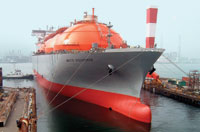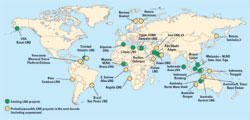Global LNG market is in transformation
LNG OutlookGlobal LNG market is in transformationRecent years have produced some of the most significant changes in the LNG business, prompted by geographic broadening of demand, increased numbers of buyers and growing supply competition. These trends will accelerate in the coming decade.From the first commercial shipment in 1964 to the mid-1990s, LNG trade was based almost exclusively on rigid, long-term contracts. Dominated by Asia, the number of countries supplying and receiving LNG was limited. Indeed, the LNG trade defined a fairly exclusive group of countries and companies for over 25 years. Relationships between sellers and buyers were key, particularly in the Pacific basin. Maintenance of long-term security of supply was paramount. No single event signaled a shift in the status quo since the mid-1990s, but the business has undoubtedly undergone more change in the last five to 10 years than in the previous 30 years. Key developments were:
This evolutionary surge was induced by market requirements and the competition to supply them. These factors will transform the business at an even greater pace in the next decade, in terms of volume, geography and complexity.
RAPID DEMAND GROWTH Such market growth will be visible geographically, and volumetrically. By 2015, we forecast that up to 16 additional countries, from small states such as Cyprus, to huge gas consumers like the UK, will import LNG. This is in addition to 14 countries that imported LNG during 2004. These new importers, combined with liberalization in current importing countries, will set the stage for many new entities to become LNG purchasers. Demand for gas and, by extension, LNG, will continue to be driven by economic growth. In the established LNG markets of Europe and northeastern Asia, economic growth will create a steady, incremental increase in the requirement for LNG volumes. This is true for direct consumption as well as power generation. However, significant LNG demand will also come from new markets that experience strong economic growth and development. The coastal provinces of China and India will, potentially, be important sources of demand. Environmental concerns will also help to drive the requirement for additional volumes. Environmental pressure will be particularly important in Europe, where national and supra-national legislation will require power generators to switch from burning oil or coal to gas, to enhance emissions reductions. However, it is evident that environmental factors will play a key role in gas and LNG markets elsewhere in the world, including China. DECLINING SELF-SUFFICIENCY IN GAS Wood Mackenzie forecasts that the US and the UK will experience marked shortfalls between indigenous gas output and demand over the next decade, creating a significant import need. This opens the door to large LNG volumes in these markets, particularly the US. As regards the US, indigenous gas output will fail to meet expected demand. Although more distant gas resources, such as Alaska, are available, LNG is proving to be an economic supply choice. In the UK, LNG can be delivered on more economic terms than gas from several competing pipeline projects. These projects originate in other European countries, Russia, Africa or Central Asia. Thus, Wood Mackenzie forecasts that the UK and North America will have combined LNG demand of around 100 Bcm (3.5 Tcf) in 2010, compared to 16 Bcm (565 Bcf) in 2004. This volume is greater than the 2004 demand in Japan, which is the largest importer at more than 40% of the global market. The belief that at least some of this incremental demand will be realized is evidenced by the number of LNG regasification projects proposed or under development. This is particularly true in North America, where LNG regasification capacity should treble by 2010. CHANGING BUYER REQUIREMENTS In addition, some buyers used spot or short-term purchases to manage market vagaries, such as seasonal peaks, unexpected demand growth or shrinkage. However, liberalization (or threat thereof) of global gas markets is forcing buyers to adopt flexible contracting strategies. Buyers do not want to get into a situation where they lose key customers to competitors and suffer a significantly reduced LNG requirement. At the same time, they do not want to be required to pay for volumes that they don’t need under the take-or-pay provision of an inflexible, long-term supply contract. Therefore, major buyers are increasingly using a portfolio of short, medium and long term contracts as well as optional volumes to increase operational flexibility but maintain security of supply. An interesting example was a contract that TEPCO signed with MLNG Tiga in 2003 that is renewable on an annual basis. The need for flexibility is also driven by seasonality of gas demand, something that could be a requirement in the US and UK markets. Buyers are also managing price risk, by seeking new types of indexing in contracts that link LNG purchase prices to factors other than the oil price traditionally used. Examples include linking prices to spot market gas prices (such as NYMEX) or to electricity prices, where LNG is used primarily for power generation, and the generator does not want to be at a cost disadvantage against competitors. There have also been examples of contracts being linked to other competing fuels – for example, to coal in the Iberian market. In the Pacific basin, the Guangdong contract signed between CNOOC and North West Shelf LNG in 2002 signaled a shift toward pricing focused on reducing volatility, and the use of competitive tendering rather than bi-lateral negotiation. However, regional and global market conditions will dictate how flexible suppliers can be. The other major change on the demand side is that LNG buyers are becoming more active. This compares to their historically passive stance, where they just handled LNG from the discharge port onwards. Key purchasers have expanded along the LNG value chain. They have become involved in shipping and, in some cases, trading, and even liquefaction and upstream. Motivation for this strategic change is diverse and complex, ranging from a need to develop greater operational flexibility (an example is ownership of shipping) to coping with seasonality and price/ volume risks. This relates to the need to diversify revenue streams, and to take advantage of increased buying power in light of potential excess supply.
COMMERCIALIZATION DRIVES GAS SUPPLY COMPETITION While other monetization routes – GtL, DME and CNG – are gaining momentum, LNG is still the most prominent, feasible option for maximizing stranded gas values. Thus, competition in LNG supply is growing. Like the growth in LNG demand, there will continue to be an increase in the scale and diversity of LNG supply, Fig. 1. In 1995, global LNG output totaled 67 million t from eight countries. By 2004, it had reached 112 million t from 12 countries, including such new suppliers as Qatar and Nigeria. Within the next decade, overall supply should double, with five or more new countries entering the supply side.
However, the number of proposed projects has increased exponentially. By 2010, potential supply could exceed incremental demand by a factor of two or more. It is clear that not all projects will meet their proposed timetables. Many projects must be competitive, or be delayed, deferred or abandoned. BIGGER IS BETTER Although significant scale developments (train and ship sizes) will occur in the next 10 years, it is not yet clear whether this momentum will continue beyond this timeframe. With increasing scale comes the challenge of marketing larger gas volumes and potentially restricted flexibility. It is likely that only large-volume players, such as Qatar and Nigeria, will see further scale developments in both train and ship size tied to long-term, point-to-point trades. It is also likely that in areas where significant, relatively low-cost gas resources are present, companies and governments will increasingly look at developing integrated complexes incorporating LNG, GtL and other gas monetization processes. Such complexes are being developed in Qatar and Equatorial Guinea. In addition, suppliers have identified the value of integration in the LNG value chain. Historically, suppliers were content to focus attention on supplying customers and building relationships. Yet, greater competition and market liquidity have meant that creation of market “pull” for proprietary LNG, and exploitation/ protection of margin across the value chain, are growing in importance. Companies, such as Shell, BP and BG, were the first to identify that access to markets and the ability to control each part of the value chain would assist in monetizing reserves. It also would allow the flexibility required to exploit evolving opportunities. Indeed, in the last two years, many other key players in LNG supply have followed suit. INCREASING SUPPLY FLEXIBILITY Although projects historically required a high proportion of long-term, off-take commitments before a final investment decision was made, a greater level of volume risk is now being adopted by new supply projects. This risk can be traced partly to buyer need and partly to competitive effects. It is offset, to some extent, by companies’ ability to utilize their integrated positions to transport and place additional, uncontracted volumes. Companies (such as Shell, BP and BG), through their portfolios of supply, shipping and regas assets, can offer much greater flexibility to buyers without compromising the commercial integrity of supply projects. Having said this, the industry will continue to be underpinned by long-term, off-take agreements between suppliers and buyers (even if buyer and supplier are different units of the same company). But there will be increasing market liquidity and increasingly integrated portfolios. A greater proportion of the market will be traded on shorter-term or more flexible arrangements, thus meeting the buyers’ demands.
|
||||||||||||||||||||||||||||||||||||||||||||||||||||||||||||||||||||||||||||||||||||||||||||||||||||||||||||||||||||||||||||||||||||||
- Applying ultra-deep LWD resistivity technology successfully in a SAGD operation (May 2019)
- Adoption of wireless intelligent completions advances (May 2019)
- Majors double down as takeaway crunch eases (April 2019)
- What’s new in well logging and formation evaluation (April 2019)
- Qualification of a 20,000-psi subsea BOP: A collaborative approach (February 2019)
- ConocoPhillips’ Greg Leveille sees rapid trajectory of technical advancement continuing (February 2019)






